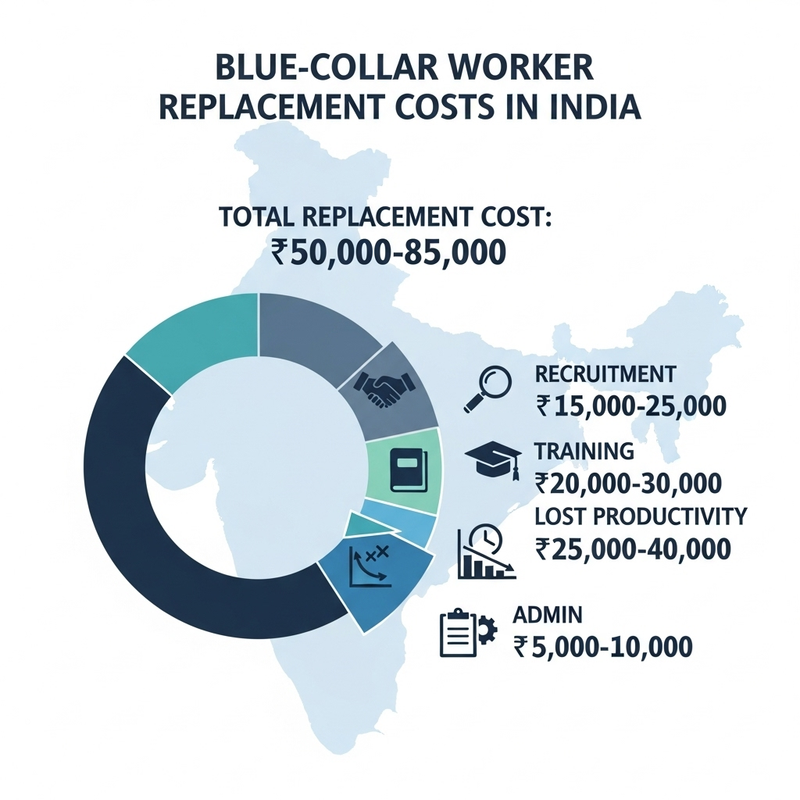What their stories reveal about building sustainable blue-collar workforces in India
Last month, I received three phone calls that changed how I think about India's gig economy. Three former security guards, all requesting to return to work. Each had quit my staffing company 4-5 months earlier to join food delivery platforms.
This wasn't coincidence. Over six months, I've documented similar patterns across multiple client locations. Workers who left for gig work's promised "freedom" are returning with stories that reveal fundamental cracks in the pure gig model.
Why They Left: The Gig Economy's Initial Appeal
When these workers first resigned, their logic seemed unshakeable:
Immediate income boost: Daily earnings of ₹700-900 versus monthly salaries around ₹20,000 Schedule control: Work when convenient versus fixed 12-hour shifts
Zero commitment: Take breaks without leave applications or approvals Personal autonomy: Be your own boss instead of following company protocols
From their perspective, who wouldn't choose potentially higher earnings with complete flexibility over predictable but rigid employment?
The Reality Check: What Actually Happened
After 3-4 months in the gig economy, these workers painted a starkly different picture:
Income Became a Daily Gamble
What appeared as higher earnings revealed itself as dangerous unpredictability. One day might bring ₹850, the next ₹180. Without steady salaries, basic budgeting became impossible.
"Sir, I never knew if I'd have money for my daughter's school fees this month," one worker explained. "With you, I knew exactly ₹16,000 would come. With the app, some weeks I made ₹3,000, others ₹1,200."
The Algorithm Wars Never Ended
Perhaps most exhausting was constantly battling ever-changing platform algorithms. Workers described a weekly cycle of learning and relearning:
- Week 1: Master peak delivery hours and efficient routes
- Week 2: Platform updates algorithm - previous knowledge becomes useless
- Week 3: New bonus structure requires completely different strategy
- Week 4: Penalty system changes, erasing weeks of progress
This isn't flexibility. It's uncertainty disguised as freedom.
Human Support Vanished When Needed Most
When problems arose - wrong addresses, customer complaints, app glitches - automated systems imposed penalties first and investigated later, if at all.
Workers missed having supervisors who understood context, could exercise judgment, and provided face-to-face problem-solving when issues occurred.
"When something went wrong with you, I could talk to someone who knew me," another returnee said. "With the app, I'm just a number in their system."
The Hidden Economics: Why High Attrition Is Killing Profitability

Individual stories aside, the broader financial implications are staggering. Industry data shows replacing each blue-collar worker costs ₹50,000-85,000:
- Recruitment: ₹15,000-25,000 for portals, screening, interviews
- Training/Onboarding: ₹20,000-30,000 for safety, systems, certification
- Lost Productivity: ₹25,000-40,000 during 2-3 month ramp-up period
- Administrative: ₹5,000-10,000 for documentation, equipment, compliance
With monthly attrition rates exceeding 15% industry-wide, a 100-person team potentially loses ₹12.75 lakhs monthly - ₹1.53 crores annually - purely in replacement costs.
This transforms attrition from an HR challenge into a survival-threatening financial drain.
What Gig Platforms Get Right (And Catastrophically Wrong)
The gig economy addresses real limitations in traditional employment:
Valid innovations:
- Immediate income without lengthy hiring processes
- Performance-based rewards exceeding fixed salaries
- Work-life balance flexibility
- Lower entry barriers for workers

Critical failures:
- Confusing unpredictability with flexibility
- Shifting all risk to workers least equipped to handle it
- Creating algorithmic dependency that burns out performers
- Offering zero career progression or skill development
The Third Path: From Gig to Career
Instead of choosing between gig flexibility and employment stability, smart companies are designing systems offering both.
Based on returned worker insights and successful workforce model analysis, I've developed a "Gig-to-Career" pathway:

Phase 1: Flexible Entry (Months 1-3)
Workers start on gig-like arrangements with immediate income and scheduling flexibility while being evaluated in real work conditions rather than artificial interview settings.
Phase 2: Merit-Based Conversion (Month 4)
Top 30-40% of performers receive formal employment offers with comprehensive benefits, job security, and cultural integration support.
Phase 3: Career Development (Months 6+)
Structured training programs, clear progression pathways from worker to coordinator to manager, and mentorship pairing new employees with veterans.
Early Results: The Numbers Don't Lie
Six months of testing this framework with select clients shows promising outcomes:
- Retention: 70% of converted workers stay beyond 12 months (vs 30% with pure gig)
- Quality: Customer satisfaction scores increased 15-20%
- Costs: Total cost per productive hour decreased despite higher individual wages
The insight: workers want a performance-based pathway from flexibility to stability, not permanent commitment to either extreme.

Implementation Roadmap for Operations Managers
Companies considering this approach need careful attention to:
Legal Compliance: Proper worker classification during each phase and smooth contractor-to-employee transitions
Performance Metrics: Objective, measurable conversion criteria maintaining fairness and transparency
Training Infrastructure: Structured development programs justifying higher permanent employee costs
Management Evolution: Shifting from viewing labor as commodity to developing strategic assets
The Competitive Advantage
The "boomerang effect" signals broader Indian labor market shifts. As gig economy limitations become apparent, companies recognizing this trend early gain significant advantages:
- More stable, skilled workforces
- Higher customer satisfaction
- Lower total operational costs
- Stronger employer branding in competitive talent markets
Beyond Theory: Practical Next Steps
For operations leaders experiencing similar worker returns or high attrition:
- Track your boomerang rate: How many former employees are requesting to return?
- Calculate true replacement costs: Include all hidden expenses, not just obvious ones
- Survey departing workers: Understand real reasons beyond exit interview scripts
- Design pilot programs: Test hybrid models with small teams before full implementation
The future belongs to organizations offering both worker-craved flexibility and ultimately-needed stability.
Ready to explore Gig-to-Career pathways for your organization? Schedule a consultation to develop sustainable workforce solutions tailored to your industry's specific operational needs.


